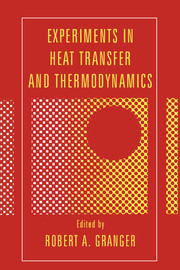Book contents
- Frontmatter
- Contents
- Preface
- Introduction
- Part I Experiments in heat transfer
- I.1 Conduction
- I.2 Convection
- I.3 Boiling
- I.4 Mixing, dispersion, and diffusion
- I.5 Radiation
- I.6 Heat pipes and exchangers
- Part II Experiments in thermodynamics
- Experiment 26 Effect of surface condition on attainable superheat of water
- Experiment 27 Experiments for compressibility and vapor pressure
- Experiment 28 Determination of time constants
- Experiment 29 Very fast versus very slow processes: Which are more efficient (closer to reversibility)?
- Experiment 30 Determination of volumetric fraction of each phase in multiphase flow
- Experiment 31 Measurement of the latent heat of vaporization of a liquid
- Experiment 32 Dilution techniques for the performance evaluation of continuous-flow combustion systems
- Appendix 1 Experiments and demonstrations in thermodynamics
- Appendix 2 Experiments and demonstrations in heat transfer
- Appendix 3 Heat-transfer and thermodynamic films
- Index
Experiment 26 - Effect of surface condition on attainable superheat of water
Published online by Cambridge University Press: 05 June 2012
- Frontmatter
- Contents
- Preface
- Introduction
- Part I Experiments in heat transfer
- I.1 Conduction
- I.2 Convection
- I.3 Boiling
- I.4 Mixing, dispersion, and diffusion
- I.5 Radiation
- I.6 Heat pipes and exchangers
- Part II Experiments in thermodynamics
- Experiment 26 Effect of surface condition on attainable superheat of water
- Experiment 27 Experiments for compressibility and vapor pressure
- Experiment 28 Determination of time constants
- Experiment 29 Very fast versus very slow processes: Which are more efficient (closer to reversibility)?
- Experiment 30 Determination of volumetric fraction of each phase in multiphase flow
- Experiment 31 Measurement of the latent heat of vaporization of a liquid
- Experiment 32 Dilution techniques for the performance evaluation of continuous-flow combustion systems
- Appendix 1 Experiments and demonstrations in thermodynamics
- Appendix 2 Experiments and demonstrations in heat transfer
- Appendix 3 Heat-transfer and thermodynamic films
- Index
Summary
Principle
A fluid must be superheated above its saturation temperature for nucleate boiling to occur. The amount of liquid superheat sustainable is influenced by the presence (or absence) of nucleation sites.
Object
To measure the superheat required to boil water for containers having different surface characteristics.
Background
At one atmosphere pressure, the saturation temperature of water is 100 °C. When a pan of water is heated to 100 °C on an electric heating element, you will observe columns of steam bubbles rising from the base surface of the container. This is nucleate boiling. However, the water in the thin thermal boundary layer near the heating surface is superheated to a temperature greater than 100 °C. Thus, its temperature is greater than the 100 °C saturation temperature.
This experiment demonstrates the degree to which water may be superheated, and the effect of “nucleation sites” in the container wall on the amount of superheating that occurs.
A microwave oven is used for the experiment, because the microwave supplies approximately uniform heat per unit volume to the water.
Apparatus
One litre of degassed water
A clear glass beaker
A microwave oven
A thermocouple to measure the water temperature
A handful of clean sand, or other insoluble granular material
Procedure
The water is first “degassed” by vigorously boiling it in a pan, using a surface heating unit.
- Type
- Chapter
- Information
- Experiments in Heat Transfer and Thermodynamics , pp. 205 - 207Publisher: Cambridge University PressPrint publication year: 1994



